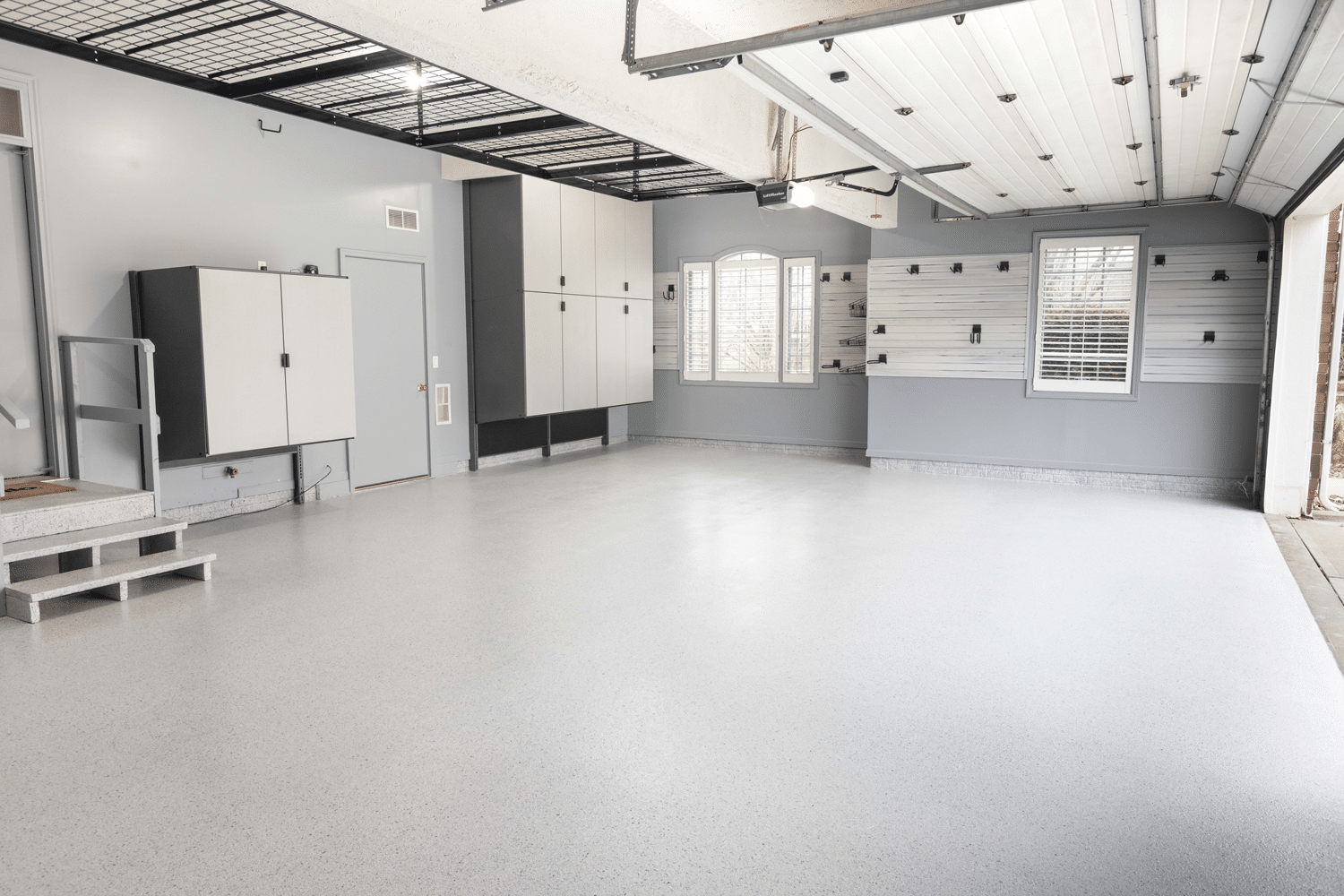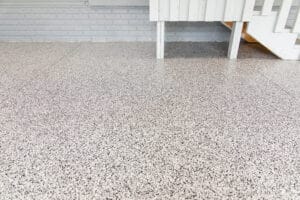If you’re looking to invest in a garage makeover, there’s no better way to refresh your space than kicking that nasty, dirty, oil-stained garage floor to the curb. The problem? There are so many options to choose from, it can be hard to know what’s what. Luckily, we have you covered!
Keep reading to learn about the different types of garage floor coatings and which one is worth the investment.
Garage floor coatings – what’s the difference?
Truth be told, no amount of paint, lighting or shelving units can make the same impact on a garage as a shiny new floor. As you’d expect, there are all sorts of options for your garage floor, including:
While any of the options above will give your garage a new look, polymer coatings tend to be the best bet in terms of looks and longevity. This leaves us with three basic options: epoxies, polyureas and polyaspartics.
Polyurethane vs. Epoxy Garage Floor Coatings
Epoxy coatings tend to be less expensive and easier to apply than other options. However, even when professionally installed, they are prone to peeling and cracking over time. Epoxy coatings aren’t very UV resistant either, and will start to yellow with repeated exposure to UV rays.
Newer polyurethane products do tend to perform better than epoxies, but they take twice as long to install as other options — up to four days to fully cure. That lengthy cure time requires them to be applied in a thin layer, which makes them more likely to peel and crack.
And the cons don’t stop there! The solvents used in polyurethane coatings emit Volatile Organic Compounds or VOCs, both during application and once cured.
Polyaspartic Floor Coatings
When professionally installed, polyaspartic coatings typically don’t suffer the same problems as epoxies and polyurethanes. They are safe, durable, long-lasting and offer a granite-like look and feel. Current polyaspartic options available to consumers are the culmination of decades of research and development.
Today’s polyaspartic floor coatings are engineered to look better, wear harder and last longer than epoxy or polyurethane options. Though the technology has been perfected over the past few decades, polyaspartic coatings were mainly used in commercial applications such as hospitals and airplane hangars until recently.
Why choose polyaspartic floor coating over epoxy?
Let’s take a quick look at how these coatings work. A polyaspartic floor system consists of a colored base coat, a vinyl flake layer and a clear top coat for shine and durability. Unlike garage epoxy, a polyaspartic coating is not something you buy at a big-box DIY store. That’s because polyaspartic sets very quickly, so it requires at least two installers.
Why choose polyaspartic floor coating over epoxy?
Let’s take a quick look at how these coatings work. A polyaspartic floor system consists of a colored base coat, a vinyl flake layer and a clear top coat for shine and durability. Unlike garage epoxy, a polyaspartic coating is not something you buy at a big-box DIY store. That’s because polyaspartic sets very quickly, so it requires at least two installers.
The Science Behind Polyaspartic Coatings
A polyaspartic is a kind of polyurea that was first developed in the 1990s. The full name is “polyaspartic aliphatic polyurea.” A polyurea is an organic polymer that is the result of the reaction of two components. These components are:
Better than epoxy. Polyaspartic floor coatings are stronger, more durable and longer lasting — and they look better too!
- Resin: In the case of polyurea, the resin is an amine-terminated polyether resin. Amine-terminated polyether resins replace the polyol commonly used to make traditional polyurethane.
- Isocyanate: Isocyanates are a family of highly reactive, low molecular weight chemicals widely used in the manufacture of coatings and elastomers and are increasingly used in the automobile industry. Isocyanates can be classified as either aromatic or aliphatic.When a polyurea is made using aliphatic isocyanate (as opposed to an aromatic isocyanate), the result is polyaspartic aliphatic polyurea or, for short, polyaspartic.
Because they use aliphatic isocyanate, polyaspartic coatings overcome many of the difficulties associated with aromatic polyureas and traditional polyurethanes. The result is a rubber-like compound that may be used in many of the same ways as older technologies like epoxy or polyurethane — but with better performance.
Another big advantage of aliphatic isocyanates is their color stability. Aliphatic polyurea coating systems are UV-stable. Even when exposed to direct sunlight, UV-stable compounds experience very little color fade or loss of gloss over time. In comparison, non-UV-stable polyurea products created with aromatic isocyanates will lose gloss, fade and yellow when exposed to sunlight. Eventually, these coatings experience polymer breakdown and coating failure.
The Bottom Line: Thanks to their chemistry, a polyaspartic floor coating is very tough. Polyaspartic combines high elasticity with high surface hardness, resulting in very good abrasion resistance. This is basically the holy grail of garage floor coatings.
Our Choice: Polyaspartic Floor Coatings

A polyaspartic floor coating by Hello Garage will make your garage the envy of the neighborhood!
If you skipped to this bit, here’s the deal: Polyaspartic floor coating systems are better than epoxy and polyurethane systems because they look better longer. This is due to the chemistry involved. Not all polyaspartic products are the same.
There are many aliphatic products out there that are actually blends of aliphatic and aromatic isocyanates — not what you want! Some dishonest producers will make a blend that is only 51% aliphatic and 49% aromatic and still claim it is an aliphatic product. But here’s the truth: Those products won’t offer the same durability and long-lasting beauty as a 100% aliphatic product.
So, if you’re considering installing a polyaspartic coating in your home, be sure to read the fine print and look for one with a 100% aliphatic isocyanate component.
Hello Garage: Your Trusted Polyaspartic Floor Coating Company
When it comes to high-performance garage floor coatings, homeowners throughout the United States trust the garage makeover experts at Hello Garage.
Our polyaspartic floor coating is professionally installed by our Dream Team to ensure your garage floor looks and performs its best for years to come. Better yet, we offer a wide range of stunning color options!
Let Hello Garage help reimagine your garage with a beautiful garage floor coating, versatile garage storage and organization solutions. Schedule a free garage floor coating estimate today!



